Text
Nothing More Was Ever Said

Nothing More Was Ever Said
Opening Night — Saturday 14th December, 6 - 9 pm RSVP to [email protected] — all are welcome
➻ 19 Greek Street, London, W1D 4DT 14th - 19th December 2024
In an endless silence after the last words have been spoken and with a gentle nature, a sense of calm is set free. Finally, it has been put to rest and found a new home, although it still exists within the same world as before. Inside those invisible spaces in between, without hearing, seeing or saying, the void quietly suggests it is the end.
Orla Carolin, Eveleigh—Evans, Hugh Frost, Jack Ginno, Kirsty Harris, Caroline Jane Harris, Friedrich Herz, Caitlin Kelly, Sam Llewellyn-Jones, Dustin London, Tom Parker, Marija Rinkevičiūtė, Emma Tod, Asha Vaidyanath, Hannah Waldron, Zoe Wu, Yilina Yang
1 note
·
View note
Text
Sprinkle Water on the Web

I am happy to announce my next solo exhibition ‘Sprinkle Water on the Web’ will be at Galerie Tator in Lyon opening on 7 April – 26 May 2023.
The web is sticky The shell is shiny In it I can see everything Neophytes Tatterdemalions A flighty amanuensis, blades of grass clutched tight Flames scissored, dissected and spun. It is here that things happen, here that the world is won.
(Extract from a text written to accompany the show by Charlie Duck, 2023)
Image © ‘Wild Flowers in the Web’ (Detail), Hannah Waldron, 2023
3 notes
·
View notes
Text
Care Takers solo exhibition at Newlyn Art Gallery

Earlier in the year, I was invited to have a solo exhibition in the Picture Room space at Newlyn Art Gallery (UK). Between February and April I exhibited a body of work Care Takers. Using weaving, but also incorporating embroidery I made a collection of small-scale works that drew together slow observations from my recent period of pregnancy and mothering a small baby as a way to document that period in my life and the certain space-time that that transformation enacted upon me.
“Care Takers is a body of work that has been produced slowly over the course of a year whilst I have been taking care of my new baby daughter. The act of care-taking became at the forefront of everything for me this year, yet when looking at the numerous acts of care taking place in society and nature, they are so often overlooked and fade into the background of what is valued. I wanted to use this opportunity to bring my attention to and celebrate acts of taking care within my environment; from nature based observations in the garden at my studio, to unseen ways in which care taking and nourishing interaction occurs in nature, for example underground mycelium networks, through to the process of handweaving itself.
These new series of weavings have been produced on a small handloom, using yarn dyed with natural dyes including woad, madder and weld, and embroidered at intervals on long walks around Falmouth whilst my daughter was sleeping.”

I also created one large hanging (see top) which I will be expanding upon in a series of new pieces as I work towards two solo exhibitions next year.

I would like to say a big thank you to Fran and everyone at Newlyn Art Gallery for their support in making this exhibition happen, and a dedication to anyone whose life is currently centred on care taking.

To see further images, please visit this page, where some of these weavings are currently available to purchase.
1 note
·
View note
Text
Solmania research and reflections
My work has always mirrored my life. Making for me has always been my way of processing what I experience, intuitively giving form to the thoughts and feelings as a way of navigating. Life is a complete sensory experience, multifaceted in materiality, layered in time and space. For the past ten years I have found weaving a way of making tangible the way I have treasured my life experiences, and trying to express in a physical way that I can hold, how much they mean to me.
I have realised how much time it takes for me to be able to understand what it is and why I make. A recent conversation with someone dear made me realise this. ‘But you have yourwork, as a way of processing, to funnel everything into it.’ Yes it is true, I don’t know where I would be without having my work to do.
It is coming up to a year since I had my solo exhibition at Fotokino in Marseille and it is only now, (with all things that have taken place this past year) that I start to be able to articulate my thoughts in complete sentences around the work I made.
SOLMANIA

The title of the show SOLMANIA and the body of work around it arose from my recent life of the previous 3 years of having this new person in my life - my son Sol, born on midsummers day 2017. In these years I have experienced him as this incredible force in my life, and so strong a force I cannot help but channel into my work. With his wild mop of bright sunshine hair he shakes his head back and forth, and throughout those 2s and 3s he feverishly swings between terror and delight - one moment all benevolence and sweetness, the next destruction and raw wild energy tyranny (or so we perceive). In these moments I always come back to his namesake, the symbol of the sun, this bright and fierce star at the centre of our galaxy.

This icon of the sun has also been a way for me to process concerns and feeling around the climate emergency. I've found myself looking into historical and cultural relationships to the central cosmic force of the sun to inform human existence on Earth.
In most parts of the world at some point or else ancestors across the globe worship, revered or feared the Sun in some way. In the colder parts of the world, it tended to be that the Sun was a female deity of a benevolent nature, worshipped and celebrated - whereas in the hotter climates the Sun was often a male deity, a malevolent force that threatens society, and forced to be appeased by sacrifice and offering. Other societies assigned a both female/ male or non gender conforming identity to the Sun deity such as Amaterasu in Japan.
Artefacts have remained from all parts of the world that demonstrate creative practices engaged with the Sun as an important force.
From a European point of view the Sun disappears at night and half of the year and the artefacts such as Sun discs reinforce this dualism in symbolic images produced i.e. image this SunDisk in Trondheim in Norway.
'In simple, pre-industrial pagan societies, people knew that they had somehow to propitiate and to harness the forces or agencies they encountered in the world over which they had no secular means of control. The first farmers were especially vulnerable to these forces – crops could fail through blight one year and flourish the next - drought or flood could wreck their lives and cause starvation. There are two related ways of reaching the divine-by repetitive, sympathetic magic and by image making. In terms of solar belief systems, an example of sympathetic magic is the fire festivals where bonfires are lit at Midsummer to assist the Sun as it reached its solstice apex in its annual journey across the sky. An example of image making is the simple replica of the Sun which were scrawled as rayed or concentric circles on rocks by Neolithic people at Val Camonica in northern Italy to acknowledge the Sun's arrival in the morning and it's sinking into the underworld at night.' - The Sun-Gods of Ancient Europe (GREEN 1991)

Scans from my notebook, images from ‘The Sun in Myth and Art’ by Madanjeet Singh
This idea of image making as a way of reaching the divine sticks with me as a sort of mantra as I work. Being an artist making images has always been that space-time apart from it all – the elsewhere – where I disconnect or hope to disconnect from the dictates of my everyday reality. What does it mean to reach the divine in the 21st century? I think about this as I work, and images form. I cannot even imagine coming close to reaching any sort of divinity with a hectic juggler existence of life with a toddler, but through embedding and entangling my work practice into my every day life as a care giver, there are hints and snatches where time collapses momentarily and I get a glimpse of that elsewhere.

Scans from my sketchbook
FOUR WORLDS
During much of the research I undertook surrounding sun deities, I kept stumbling across weaver goddesses and in particular creation myths where the central makers of the worlds were female weavers of one kind or another. It struck me again how these myths and stories were and are so central to various communities in defining and navigating realities, and also how weaving as a process continues to show me how it contains so much metaphor and such a close relationship to storytelling simply through the process itself.
I wanted to find a way to illuminate some of these myths. I chose to create four weavings that take on four myths from around the world and time and posit the weavings as design fictions i.e. actual woven artefacts that remain or are integral to the myths - in one sense in order to fully immerse myself in the role of the world makers that to me is the essence of what the weavers represent in the thought of these myths and to enable me to construct a site of imagination where I and I hope others can enter these worlds as a kind of material bridge.

6 notes
·
View notes
Text
Solmania at Studio Fotokino




Solmania
10 October -22 November 2020
Studio Fotokino - Marseille, France
I am so pleased to announce that my solo exhibition at Studio Fotokino in Marseille is now open.
Initially scheduled for spring, this monographic exhibition presents sketches, drawings and tapestries made for the occasion. With these pieces, the English artist weaves stories steeped in cosmology and mythology, while probing the representation of space and time.
- Studio Fotokino, 2020



Four Worlds
Alongside the exhibition, I am also very happy to present my latest publication, produced by Fotokino Editions -
Published on the occasion of her exhibition “Solmania” at the Studio Fotokino, Marseille, this work displays on paper 4 tapestries of Hannah Waldron. Each one is reproduced as a concertina book, and is accompanied by a text written by the artist.
The female weavers featured in these artworks represent four examples of the craftsperson as worldmaker, and relate to tales from classical Greece, the Tang dynasty in China, ancient Japan and the Hopi tribe in Northeastern Arizona.
For more info on this publication, please visit my shop
Specially commissioned process film
vimeo
11 notes
·
View notes
Text
Variations | Exhibition

Ahead of my solo exhibition that is due to be taking place this Autumn at Fotokino gallery in Marseille, France (postponed from April 2020 due to Covid 19), I am pleased to be taking part in the group exhibition Variations, alongside Jin Angdoo, Sabine Finkenauer, Marine Pagès, Geoffroy Pithon and Alexis Poline.
Visit here for further info.
17th June - 26 July 2020 14h00 - 18h30 Studio Fotokino
9 notes
·
View notes
Text
BAJA series at Ondine Ash

6 notes
·
View notes
Text
Tsutsugaki Noren X LINK


Noren (暖簾) are Japanese fabric hanging dividers, used to gently define borders between rooms and spaces. By using vertical slits and keeping empty space below the fabric, the scene beyond is partially visible, encouraging passage.

Noren are traditionally used in Japanese homes to protect from the elements and provide shade in summer and as entrance curtains to shops and restaurants. Today, noren are also displayed as beautiful artworks.
These noren artworks 'Desire Line 1' and 'Mountain Folds' by Hannah Waldron are produced by LINK, and are hand dyed by the Nagata dyeing house in Izumo, Japan. Shigenobu and Masao Nagata — fourth and fifth generation father and son craftsmen are one of only a few remaining natural indigo dye houses in all of Japan.
'Desire Line 1'
“This work was inspired whilst on a journey to find James Turrell's House of Light in the Tsumari Echigo region of Japan, which I reached by cycling up a very steep winding mountain path. But this work speaks more broadly of a journey of realisation, an emerging awareness of the interconnection of everything - a desire line towards trying to understand my place in the world as integrated with nature, rather than apart from. For me, this Desire Line series serves as a mantra for reconfiguring my own personal connection to the world.”
'Mountain Folds'
“This work has its origins in the sight of mountains appearing tissue paper thin, unfolding and receding into the distance on a misty morning whilst cycling in the Echigo Tsumari region of Japan. I was cycling around the Art Field Triennale visiting artworks nestled in the landscape, which is symbolised here with the red square. I was also intrigued about the tsutsugaki process and designed patterns that I thought would make an interesting translation in the hands of the master craftsmen at the tsutsugaki workshop. Similarly with the gradient I was keen to see how they would work with the traditional indigo-dyeing dipping process to achieve the ombré.”


Read more in Hannah���s blog post or see more photos in LINK’s blog post (Japanese)
Buying enquiries please visit LINK's page
3 notes
·
View notes
Text
Japan Journal pt4: Izumo tsutsugaki workshop production visit
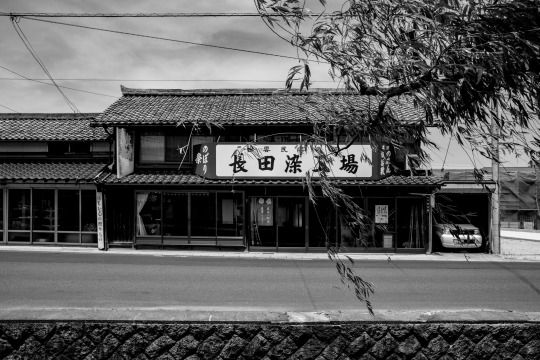

I have been collaborating with LINK textiles for a number of years creating artwork for furoshiki - a traditional Japanese textile format- a multi-functional square piece of cloth, historically used to wrap clothes to transport to the bathhouses, and in more recent times to wrap gifts with. Each design I have made explored the portability of the function, the nomadic qualities of these transportable cloths, as subjective maps.
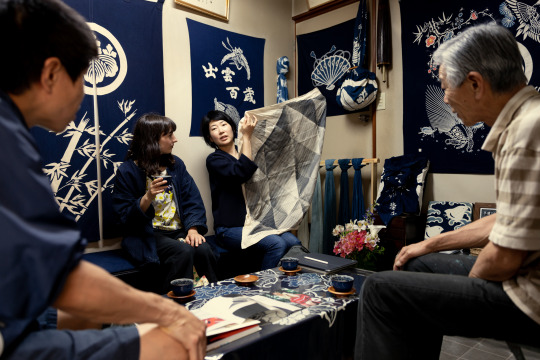
Recently I was invited by LINK to create artwork for another traditional Japanese textile process - tsutsugaki - literally meaning ‘tube drawing’, which uses a rice paste to act as a resist in combination with natural indigo dyeing, to create textile artworks, historically produced as wedding gifts in the form of bedspreads, and wall hangings, and also as ‘noren’, curtains that act as inviting entranceways to spaces. Having witnessed some beautiful examples of tsutsugaki noren on my last trip to Japan in 2012, and always keen to embrace the limitations and therefore potential of a new process, I was delighted to accept this commission. As luck should have it, I was able to join Kyoko of LINK on a production visit of the tsutsugaki workshop in Izumo, this May, as part of my QEST research trip.

Landing in Tokyo, I skirted around the city, from Narita to Hakeda airport to join LINK creator Kyoko and long-term photographer of all things LINK Martin Holtkamp to fly to the far west of the main island of Honshu, to the small coastal city of Izumo. Getting on the small bus that took us on the short hop from the airport to the centre, glimpsing fragments of the landscape as the sun set, we settled into the quiet confidence of the place, pulsing along to its own quiet rhythm, which I discovered is steeped in spiritual history, craft and its own distinct culture. After the most delicious seafood feast in a quiet backstreet of Izumo, and a midnight dip in the hotel’s own onsen, I felt perfectly at home.

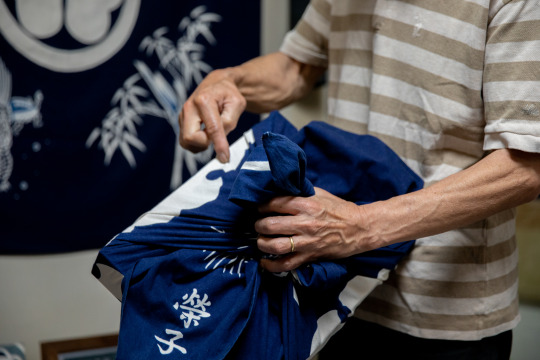
The next morning, we arrived at the workshop to be greeted by Mr Nagata and his son, and their dog Beck in a cosy corner of their workshop, the entirety of the space adorned with their craftsmanship - wall hangings, furoshiki, banners, table cloths and more. Over Japanese tea for the next hour Kyoko and the father-son duo discussed in Japanese the intricacies of the technique, the current state of the industry of Japanese craft textiles, the tools, their customers, as well as the rich culture of Izumo. We were shown work from his ancestors from the Meiji period, a baby blanket of exquisite detail, fortuitous cranes and turtles under a sunset cloud, and a bed spread of family crests, sewn together from 4 pieces, still luminously rich with indigo, despite the passing centuries.

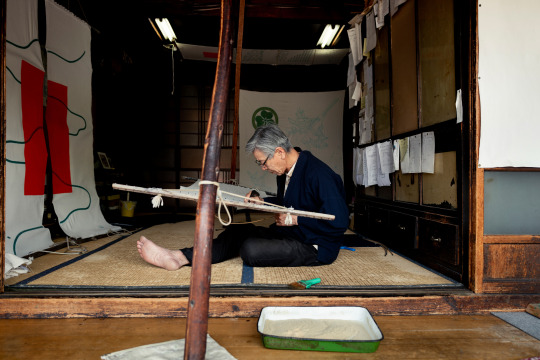
We were then guided through the process through a series of demonstrations. I spotted my artwork draped in mid air above our heads, and another half of the noren was retrieved and suspended it the upper part of their studio in order for Mr Nagata senior to demonstrate the application of the design, the ‘tubedrawing’. He filled his tube tool with the paste, and began to ‘paint’ on my design, that had already been marked out in pencil, sucking on the tube every few minutes to release air bubbles, and he sat with repose on the tatami mat, in the morning light, attentively applying the resist paste to the cloth. After completing a section, he would throw on some rice husks and dust them across the work, to help seal in the paste to the fabric.


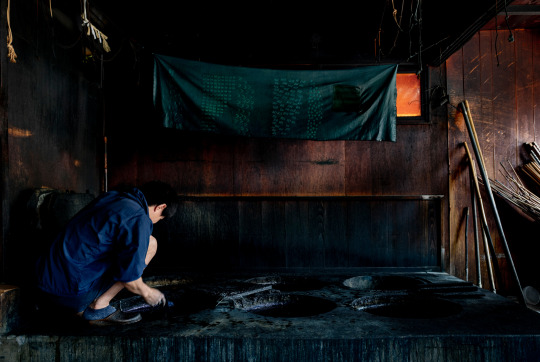
The dyeing room was his son’s domain and we watched with delight seeing the magical transformative process of indigo dyeing take place on our noren pieces. The dyeing room with the 6 vats sunken into the ground had the patina of countless years of dyeing and we couldn't help but watch with wonder as we witnessed the metamorphosis from white to green to blue, as the oxidation takes place. Above the dye vats in the corner of the ceiling we noticed a shinto shrine to the goddess of indigo dyeing, commonly told to be filled with jealousy should any female do any dyeing, so indigo dyeing is strictly a male business.

Seeing our designs be submerged in the the vats, and remerge transformed into colour so rich, for fabric to be so utterly transformed by the power of nature was a bewildering thing to watch, and what struck me was how gentle this process seemed. Rice paste, rice husks, paper tubes with a metal tip, indigo vats with only fermented natural indigo and nothing else added. Then the large fabric swathes are taken out to the canal just outside the workshop, tied to a pole in the middle of the gushing river, and the rivers flow washes the natural indigo away with a little help from Mr Nagata to beat away the remaining rice paste. It takes at least 10 dips, each having to dry for hours in-between dips, then carefully washed, dried, ironed, then sewn by Mrs Nagata on site.

After warm good-byes, bows and the trading of business cards, we were kindly driven to the local Shussai pottery, and adjoining cafe where we tucked into the most delicious curry before heading back east on the Shinkansen bullet train to Kyoto. We left filled with the joy of experiencing dedicated craftsmanship, one of only 2 remaining tsutsugaki factories remaining in Japan, and a feeling of gratitude of experiencing artistic collaboration across the world.

All photos courtesy of Martin Holtkamp / LINK
Visit https://linkcollective.com for more info on our latest tsutsugaki collaboration.
3 notes
·
View notes
Text
Japan Journal pt3- The Site of Reversible Destiny
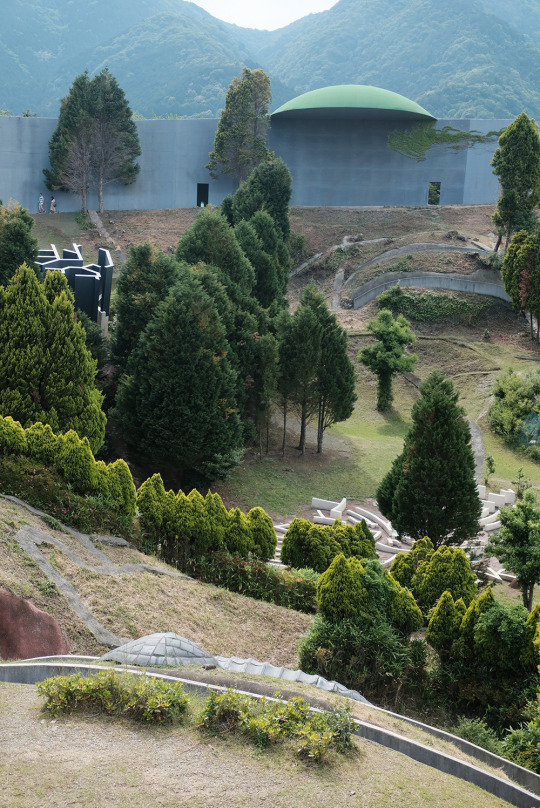
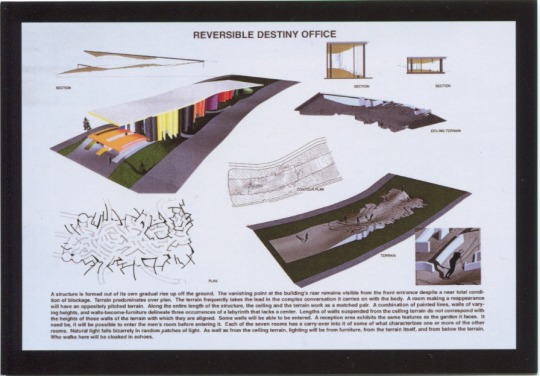

After leaving the Aritmatsu Shibori Festival, we made up way back north-east via Nagoya to visit the incredible project - The Site of Reversible Destiny.
‘Arakawa and Gins’ Site of Reversible Destiny—Yoro, is a created landscape containing a series of pavilions, undulating planes, shifting colors, and disorienting spaces that the artists presented to visitors as a place of purposeful experimentation. The work is part of the larger Yoro Park, located in Yoro, Gifu Prefecture, and opened to the public in 1995.
The first pavilion encountered is the Reversible Destiny Office (added later in 1997) that contains an uneven pastel colored maze and a ceiling that mirrors the design of the floor. The Critical Resemblance House is the next building in the park and also includes a maze with walls bisecting furniture and a map of Gifu Prefecture forming its roof. The Elliptical Field encompasses the rest of the park and is set in a concave basin in the foothills of the local mountains.
More pavilions (referred to as Architectural Fragments) are set in the terrain of the Elliptical Field and have names such as Exactitude Ridge, Trajectory Membrane Gate, Zone of Clearest Confusion, Mono no Aware Transformer, and Imaging Navel. Additionally, the Elliptical Field contains an intricate network of 148 paths and 5 maps of Japan placed at different scales throughout the landscape. The vegetation includes 24 different breeds of herbs selected by Arakawa and Gins to emphasize the changing of seasons.’ (Text taken from http://www.reversibledestiny.org )
Visiting the park became like entering a new world full of latent possibilities. Arakawa and Gins believed that changes in bodily perception would lead to changes in consciousness thus they developed architecture and environments to challenge the body as a way to "reverse our destinies." Arakawa and Gins’ wish was for visitors to explore the site like children and to reorient perceptions and discover the unlimited possibilities of the body.
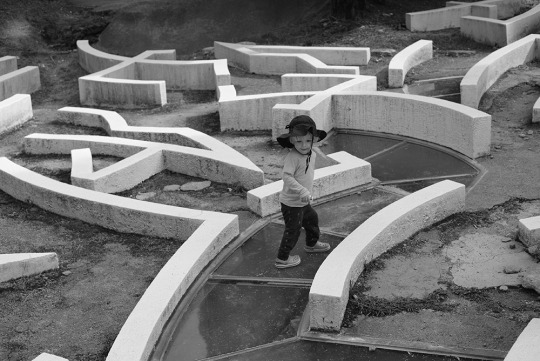
Sol exploring the site
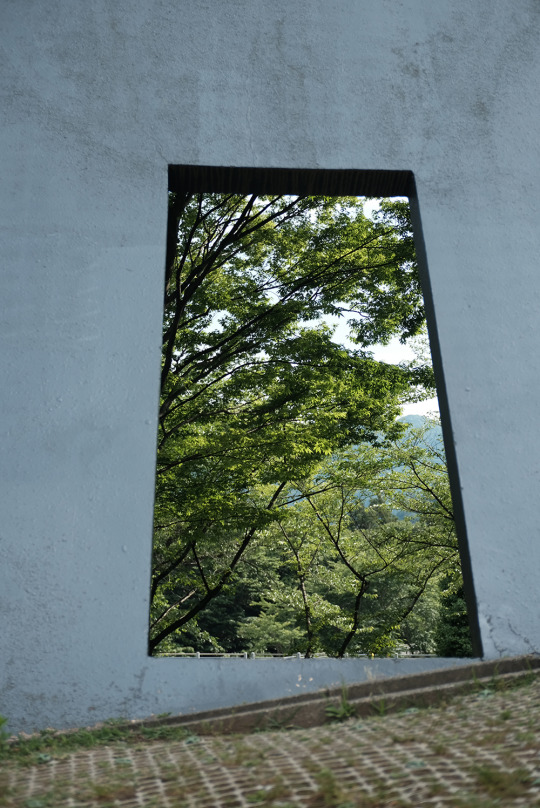
The site requires an increased bodily awareness, an attention to terrain, and and unexpected forms that aim to sharpen the mind. The entire landscape acts upon you like a thought experiment in the potentiality of bodily perception, testing body and mind and interaction in a way that feels completely bizarre and challenging to how one is used to traversing a site. It was truly wonderful to visit this legacy to the visionary couple, for further reading they published a number of books including ‘Architectural Body’.
Prepare to be astonished!
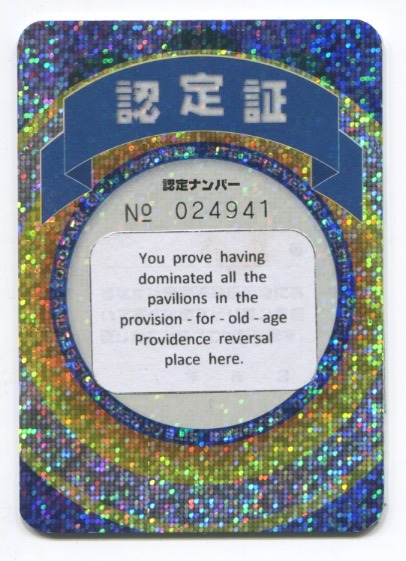
2 notes
·
View notes
Text
DOMEY x Hannah Waldron

My latest collaboration is a fun translation of my Kreuzberg weaving into a miniature enamel pin badge with San Francisco based Domey Pins.
Domey’s mission is to promote and support independent artists by curating and creating the best enamel pins, working with top artists and illustrators to create original wearable art work in their artist series.


… Additional info … 2.5 cm wide x 3.8 cm high hard enamel (cloisonné) pin with 2 metal backings Rose gold plated metal. Packaged on a Domey backing card in one of my gift boxes, and all orders currently receive a free Lion print.
Available in my shop now.
A huge thanks to Domey for the opportunity, take a look at their whole Artist Series here!

5 notes
·
View notes
Text
Japan Journal pt2 - Shibori


Serendipitously my QEST scholarship research trip to Japan coincided with the annual shibori festival in Arimatsu, a small town on the outskirts of Nagoya, with a 400 year rich history of trading shibori textiles. One Saturday morning on the hottest of June days, we took an early morning bullet train east out of Kyoto arriving there just an hour later, welcomed off the train by a host of cloth enthusiasts to this incredible two day event. The festival takes place mostly on the main thoroughfare, a pedestrian street lined with shibori traders, artisans demonstrating techniques, and shibori exhibits. The street is then punctuated by squares where public workshops and musical performances take place, street food is on offer (we sampled the delicious Kakagori and Takoyaki) and Matsuri floats are on display.



The art of Japanese Shibori takes the practice of tie-dye to a level of precision and skill that is hard to conceive. With a variety of techniques, tools and applications of bindings, wrapping, pleating, sewing and clamping, an incredibly vast scope of design possibilities can be achieved. Often in combination with natural indigo dye, the cloth produced is used for a myriad of purposes. My favourite displays of the day were the beautiful banners hanging in the trees above the music stage.


After three hours of flowing along this stream of textile celebration, with my bag a little heavier with a collection of antique shibori remnants I bought, we said goodbye to Aritmatsu, and headed back west to our next stop - The Site of Reversible Destiny... (next Japan Journal post coming soon)
Later on during our time in Japan, we visited our dear friends Ai-Aii Blue at their workshop on the beautiful island of Awajishima, where we got 1-2-1 tuition and got our hands blue ourselves making Tenugui - I tried out stitching techniques (NUI) whilst Hugh tried a clamping and folding technique (ITAJIME).
Sally and Junichi of Ai Aii Blue make imaginative, unique, contemporary Shibori indigo products using local natural indigo from Takamatsu where it is grown.They also had some indigo growing wild in their garden which they showed us, and also in its fermented dried state.




Sally and Junichi (AiAiiBlue) and their family at their home workshop.
Next year in 2020 AiAii Blue will begin a new adventure of opening a Shibori indigo dyeing workshop open to the public in Sumoto on Awajishima, with a shop and workshops. Keep an eye on their instagram for updates and make it a must if you’re ever in the region, they are the best of people and never cease to inspire me. In fact it was Sally who gave me my first weaving lesson, her creativity is astonishing!

Indigo Shibori curtain by AiAii Blue (Image from sally-junichi.com)
The last Shibori highlight of the trip was another lucky catch - an exhibition of Indigo Shibori works by Motohiko Katano at The Japanese Folk Crafts museum in Tokyo. And we also managed to turn up on the day they open the house of Mingei founding father Soetsu Yanagi. I could of spent all day in this wonderful museum, and fell even more in love with Shibori and Kasuri.

10 notes
·
View notes
Text
Japan Journal pt1 - Kasuri course

This summer I was awarded a QEST scholarship fund to travel to Japan to learn the traditional Japanese ikat weaving technique of Kasuri at Kawashima Textile School in Kyoto. In late May to early June I spent 10 days going through all the stages of this meticulous process, creating two samples, and learning a great deal along the way.

Since journeying into textiles 10 years ago, I have been fascinated by the ikat process and in particular the Japanese iteration of Kasuri.
Kasuri is a technique whereby warp and weft threads are resist-dyed methodically to create patterns and images. Prior to dyeing, sections of the warp and weft yarns are tightly wrapped with thread to protect them from the dye. When woven together, the undyed areas interlace to form patterns.
On my masters course at Konstfack in 2014 I experimented independently with resist techniques, resulting in some pleasing haphazard samples, but I was left perplexed by the mathematical precision needed to design specific forms, so I was delighted when QEST offered me a scholarship to travel to Kawashima to grasp the knowledge behind the magic.


Samples shown to us during the course.
This incredible course, taught by the brilliant Sensei Emma Omote, was rigorously rewarding in the amount of knowledge we were given over the 2 weeks. Alongside the practical work where every stage was attended with precision I have never before encountered, we were enabled through the resources of the course and discussion with the other students from all over the world to be immersed into the history of the technique both in Japan and through other ikat disciplines globally.

Having this opportunity to deeply engage with this weaving process in the context of Kyoto with all its rich history of textile practice was such a gift. I will in particular remember my daily walk along the Kamo river to take the train out to KTS.

A huge thank you to QEST for enabling this research trip, and to Sensei Emma for her amazing teaching, and to the other weavers on the course who were so generous with sharing knowledge.


Samples I made during the course.
Really excited to now bring my understanding of the technique into my own weaving, and see how I can translate to my own visual language and in particular ideas related to my Fabric of Space-time research.
5 notes
·
View notes
Text
A Day to Remember - 675 Robin Day chair - 15 Interpretations

Launching today! A Day to Remember - Initiated by Case furniture in collaboration with Heal’s fifteen unique interpretations of Robin Day’s iconic 675 chair will be auctioned in aid of The Robin and Lucienne Day Foundation.

Myself and 14 other British textile-based designers were invited to pay tribute to the 675 chair by customising the chair. I contributed my Fabric of Space-time textile, with its starry grid nodding towards the modernist era of Robin and Lucienne Day and the space race era of the 1950s.
Designers include: Eleanor Pritchard, Donna Wilson, Charlene Mullen, Cristian Zuzunaga, Wallace & Sewell, Eley Kishimoto, Hannah Waldron, Beatrice Larkin, Catherine MacGruer, Darkroom, Bill Amberg, Stitch by Stitch, Margo Selby, David Irwin and Christopher Farr.
The designs will form part of a three-week window display and in-store presentation at Heal’s flagship store on Tottenham Court Road from 1st to 21st August 2019. All proceeds will be donated to the charity, by supporting the educational work of the Foundation which help improve the future of young British designers.
Bidding starts today, live at Jumblebee ! #ADayToRemember #675chair#casefurniture
0 notes
Text
QEST scholarship to Japan

Image: Kawashima Textile School
This May/June I will be travelling to Japan, as the result of being awarded a QEST scholarship for professional development. The main activity I will be undertaking is a Kasuri ikat weaving course at the Kawashima Textile School in Kyoto, a process that has long fascinated me, and which I hope to investigate to further my research in weaving as a medium for storytelling.
This trip also provides an opportunity to connect up with my long term collaborator LINK, to work on a new exciting project together, creating a NOREN curtain in a traditional indigo dyeing workshop in Izumo. I will have the chance to visit the workshop and then we will launch the designs in Tokyo at Nui hostel lounge on the 15th and 16th June. I will also hold 2 weaving workshops and have a mini exhibition over that weekend, as well as a pop-up shop with LINK visit this page for all the info!

Over the past couple of months I have been creating a series of 5 weavings for a new hotel opening in Osaka in Japan, I will post more on this series soon, but here is a quick look at me preparing them for hanging. Exciting that this time I will be taking them in person rather than shipping them in a box!


Any tips for Kyoto and Tokyo most welcome.
And if you can make it to the event in Tokyo I would love to meet you there!
5 notes
·
View notes
Text
Frontier #19

I am excited to announce that my contribution to the award winning Frontier series, published by Youth in Decline in LA, is out now! Take a look here for more info, and to pick up a copy.
This body of work has been a really useful step for me in my research into weaving as language, as well as investigating the sensory, tactile and nomadic qualities of textiles through documenting memories of Baja California.
Frontier # 19 is a series of 15 weavings recounting memories of travel in Baja California, presented as double sided scans to reveal the hidden structure and paired with graphic forms extending the concept of weaving as language.

8 notes
·
View notes
Text
Recent and upcoming summer weaving workshops

Josie and Marieke weaving out in the midsummer sun

Class of 2018 Sätergläntan
A big thank you to The Hepworth Wakefield who recently hosted me teaching a tapestry weekend workshop to a sold out class of wonderful weavers! As it was so busy I did not manage to take photos this year, but if you head over to Maraid Design this in depth blogpost by Jane will give you a good flavour of what one of my weekend weaving workshops looks like. Thank you Jane!
I am so happy that I have been invited back to Sätergläntan this summer to teach my week long (!) Contemporary Tapestry course. Last year was such an amazing experience, it is hard to put into words. In fact, better to read textile artist and designer Laura Spring’s blogpost on her time on my course last year and while you are there take a look at her beautiful work. If you are interested in booking onto the course visit the course page and I hope to see you there!
0 notes